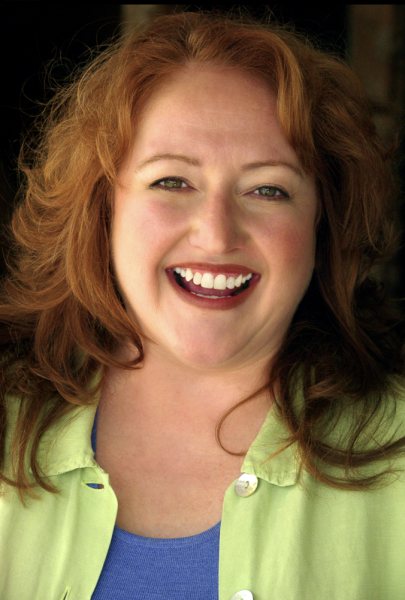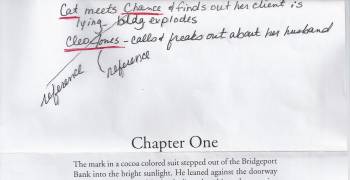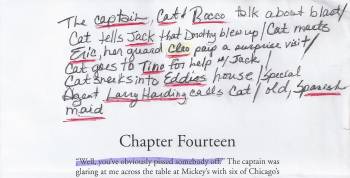|
Audiobooks: How Script Notes
Track Your Characters And Plot
 Note: The author is one of the Three VoiceKeteers presenting the Voice-Over Intensive Weekend on Jan. 15-16, 2011 in Los Angeles. Instructors are Julie Williams with "Narration Nougats," Marc Cashman on "Commercial Excellence," and Vanessa Hart, "Audiobooks A-Z." For details, please click here. Note: The author is one of the Three VoiceKeteers presenting the Voice-Over Intensive Weekend on Jan. 15-16, 2011 in Los Angeles. Instructors are Julie Williams with "Narration Nougats," Marc Cashman on "Commercial Excellence," and Vanessa Hart, "Audiobooks A-Z." For details, please click here.By Vanessa Hart
Voice Talent & Coach
©2010 Vanessa Hart
"How the heck do you keep track of what’s going on when you're narrating an audiobook?"
I get this question quite a bit, so I’m sharing what works for me.
First, a caveat. Everyone works differently, and the important thing is to find something that works for you.
TWO TOOLS
In conjunction with Script Notes that I make at the beginning of every chapter, I also use a prep tool that I call Character Sheets.
The Character Sheet is color-coded and tells everything that I know about the character, plus the voice choices I’ve made – but that’s for another article.
Today I want to talk about Script Notes. We’ll be referencing actual script notes of mine from Liar, Liar, which I narrated for Blackstone. And off we go ....
MAKING SCRIPT NOTES
 Chapter 1: After I read a chapter - making my Character Sheet notes and highlighting as I go - I return to the beginning of the chapter and write a brief synopsis of it.
This serves several purposes.
First, I know where I am in the story arc, and the arc of the various characters.
CHARACTER ARC
For instance, often a villain becomes a hero. But if he’s a villain up until Chapter 14 and then he puts on his white hat – this was indicated in the story well before Chapter 14.
When I start to see these indications, I make a note so that I know this is where I need to start to turn him.
Then, when he finally turns to the side of the angels in Chapter 14, the listener is surprised but not shocked into disbelief.
Voila. Character arc.
WHO'S WHO?
Second – meet the cast!
In Chapter 1 it’s mostly set up, but we meet three important characters.
All characters in a chapter are underlined in red.
And lastly, if I am voicing in a studio other than my own, I use this space to make a note if I’m going to need the engineer to lay in a reference marker for this character.
HEARING THEM AGAIN
For instance, here I ask for Chance and Cleo to have markers.
I ask for this before I open my mouth to voice the chapter. So, if (rather when) I need to hear these voices, the engineer/director knows right where they are and can locate them quickly.
This step saves everyone lots and lots of time. Your engineer/director will thank you for it.
If I’m working in my home studio I place a time code there.
MOVING ALONG ...
 Let’s see how this works . . . on to Chapter 10.
Wow – lots more going on here. But some of the characters don’t need reference markers.
Often characters simply appear for a few chapters in a row, and then are gone. You won’t need reference markers for those.
Also, by Chapter 10 – most, but not all characters that need markers will already have them.
The added benefit of this way of working is that if I take a moment to match the characters that appear in this chapter with my Script Notes, I’ll have a good handle on what’s coming, and know if I need to hear any of the referenced characters' voices before I begin.
THE PAYOFF
 And now the big payoff. Chapter 14.
More of the same here, and I know you understand what I’m doing by now – so what’s the payoff?
Well, in the 3rd line of my Script Notes, Cleo appears again. I have her highlighted in yellow.
Why? Because I know that she hasn’t been around since Chapter 1, and that I’ll need to hear her before I start.
I also know that she’s very important, since this is the first book in a series and at the end of this book, Cleo becomes Cat’s (the lead character) partner.
And that’s the set up for the next in the series.
SAVES TIME & MONEY
If I had not used this system, the engineer would have to find her.
And in some studios, the reference would not be there – that audio would be with the editor – out of the building, and probably asleep to boot.
So by using this little system, I’ve saved time and money. PLUS, I always know where I’m going and where I’ve been.
This works for me, and I hope you've found some helpful tips to improve your system for prepping and narrating audiobooks.
ABOUT VANESSA ...
Vanessa Hart is an in-demand voice over artist, actor, and speaker whose work is heard every day across the U.S. She has performed hundreds of commercials, corporate narrations and national television promos, in addition to narrating dozens of award-winning audiobooks. She was a finalist for Best Female Voice in the 2009 Voicey Awards competition, and a 2008 Audie Awards finalist. She is also a veteran voice coach and demo producer and works regularly from her state-of-the-art recording studio in Los Angeles.
This article is adapted from the second part of her informative training series, The Power of 5 – The Fundamentals, which is now on sale at her website. Part three will be recorded at the Three VoiceKeteers Voice-Over Intensive Weekend, Jan. 15-16, 2011 in Los Angeles.
Email: vanessahart@charter.net

Your Daily Resource For Voice-Over Success
|
|
|
For essential voice-over business strategies
Email alerts to new VoiceOverXtra articles
Inspiring interviews help your VO career
On Michael Langsner's Voice-Over Roadmap Podcast
As of the NEW website launch, 03/22/2012


.png)

.gif)




Script notes -- the way you describe them -- are a great idea, especially for fiction. I appreciate your sharing this!
DS